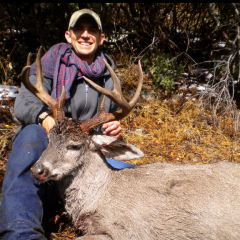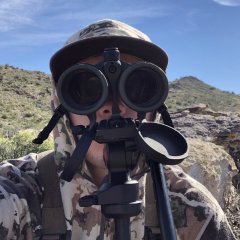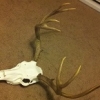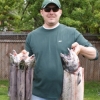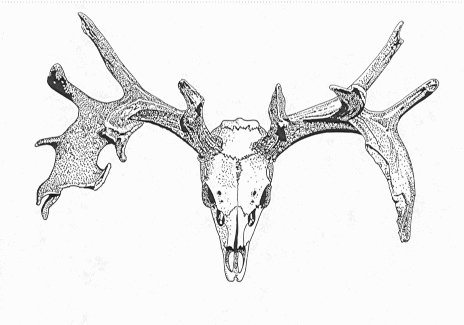

WM U37B
Members-
Content Count
12 -
Joined
-
Last visited
About WM U37B
-
Rank
Member
Recent Profile Visitors
2,845 profile views
-

Used Swarovski NL Pure 12x42 For Sale - $2650ea (2 pairs) - SOLD
WM U37B posted a topic in Optics and tripods
I have 2 pairs of lightly used Swarovski NL Pure 12x42 binos for sale. Both sets have the outdoorsmans stud installed. The glass is in perfect condition and the bodies have a few minor cosmetic blemishes. Both pairs have brand new eyecups and both come in the original boxes complete with everything inside. I'm located in Tucson, AZ. Message me directly at 520-907-6079 and I can answer any questions and send additional photos as needed. $2650 each - Sold Thanks! Ben Brochu -

Incentive rifle tag units 6a/6b/4a/5a/8/27/28
WM U37B replied to the breeze's topic in Rifle hunting for Coues Deer
Hello the breeze, It’s been a long time since I’ve been on this forum. My name is Ben Brochu, co owner of Shadow Valley Outfitters. Please give me a call at 5209076079 to discuss your hunt and what you’re looking for. We have a solid buck and I wanted to see if you’re interested in it. Thanks! -
FullSizeRender.mov
-
Thx all, I’m confident this one isn’t a hybrid.
-
Thanks Folks! GreenMachine - For the sake of discussion, what other ranges are you suggesting? I can tell you that in 2000, there was a statewide evaluation of all bighorn habitat in Arizona. In the Tucson Region, all of the ranges were scored and the Peloncillos (28) scored highest with 48 out of a possible 63 points. There was a 3-way tie for second place with a score of 47. These ranges were Aravaipa Canyon (31/32), the Catalina/Pusch Ridge complex (33), and the Mineral Mountains (N37B). There are currently sheep in all of these ranges due to translocations except for the Catalinas. Here's some interesting history of bighorn in the Catalinas 1884-94 Common in the Catalinas and were a common food source in Tucson markets 1928 USFS records suggest 220 sheep in the Catalinas 1936 Coronado NF – visual count of 23 rams, 48 ewes, and 12 lambs – 83 total 1937 71 sheep were known to exist in the Catalinas 1962 Formal AGFD surveys began following John Russo’s study which initiated bighorn management and hunting programs as we know it. Thanks again, Ben Brochu 520-591-7636 bbrochu@azgfd.gov
-
Hey All, I appreciate and respect your opinions on this project. Here are some details I wanted to point out as it relates to both this project and bighorn conservation in Arizona. First, some general information…did you know that? Since 1957, over 1800 bighorn have been captured within Arizona for restoration efforts. These efforts have resulted in the restoration of extirpated bighorn populations in Aravaipa Canyon (U31/32), the Superstitions (24B), Matzatals (22), Galiuros (32), Peloncillos (28) and the Minerals (37B) to name a few. Whether some of you know it or not, you have been aplying for sheep tags which were established through transplants just as we are doing with the Catalinas. Arizona bighorn have been used to restore desert sheep populations in Utah, Colorado, New Mexico, and Texas. During the years that the Catalinas were hunted for sheep (1962-1986), 37 rams were harvested and the Catalinas ranked #4 in the state for producing 170+ rams Generally speaking, individuals who have purchased the Commissioner auction tag for desert bighorn (low of $27,000 and high of $303,000 – 1984 to current), have harvested many of their trophy rams in restored and/or augmented mountain ranges. Now, some specifics as it relates to the project. First, we all agree that this project certainly could fail. This is something that comes with the territory. There are always inherent risks with things like this. The best that we can do is to have plans in place to mitigate those factors which may hinder the restoration, such as a plan to address lion predation, hiking restrictions which have been in place since 1996 (nothing new here), plans to increase the fire on the mountain to restore the natural role of fire and reduce unnatural buildup of fuels, etc. We have a solid plan place. When we decided to move forward with this, with the support from many conservation groups and individuals, we discussed failure many times and accept the fact that this is a possibility. One can’t fail at something without first attempting it. In our discussions about when and how we would attempt it, we decided that if we were going to do it, let’s do it right, hence the large collaring effort and cost associated with the project. Our worst case scenario is that the project does indeed fail, but we learned why it failed and at least attempted it. The local community will benefit from the significant information and education outreach opportunities this project will bring to them. I can guarantee that the general public will gain some knowledge and understanding from the project which results in more appreciation for our natural resources and for us and our role as hunters in the very successful North American Model of Wildlife Management. Any hard earned accomplishment I’ve or anyone for that matter has ever succeeded with in life has been met with some risk of failure. We accept this and move on. There were a few statements about why they disappeared in the first place. While human disturbance and encroachment have been suggested as one of the many possibilities, there has never been any solid evidence on this. In fact, in digging up all of the history associated the Catalinas, in my professional opinion; the best evidence for why the original herd disappeared in the first place may be disease. In 1986, the AGFD documented a 4 year old ram which moved over 70 miles from the Superstitions to Pusch Ridge in the Catalinas. He was ear tagged which is how they tracked him. For many decades, there has been a domestic sheep drive from the Phoenix/Apache Junction area through the Superstitions and Matzatals along the Salt River drainage eventually leading to the high country near Big Lake. Domestics and native bighorn do not do well together (pneumonia and other diseases). Many people said that the 4 year old ram “appeared” to have something wrong with it. In looking at the graph below, there is quite a sharp decline post 1986. There is also some benefit to starting fresh in a range like the Catalinas. Typically, biologists would augment a low population with new sheep in hopes that the existing sheep carry on their herd memory to the new ones. Herd memory is built up over generations and generations and includes good lambing/nursery areas, water locations, travel corridors, etc. If human encroachment did indeed have something to do with the original herd dying out, this has been lost as no sheep = no herd memory. Therefore, any new sheep placed into the Catalinas must make ends meet with the conditions available. This could be looked at as a plus. If anyone has any additional questions or inquiries, please contact me at 520-591-7636 or email at bbrochu@azgfd.gov as I would be happy to assist. I am only one of many individuals working on the project for the past 3 years. Your support would be greatly appreciated. Thanks, Ben Brochu Wildlife Manager U37B
-
All, Amanda forwarded this to me and I'll chime in. Also, JLW found and posted a similar forum from last year that was discussed at great length. The scenario described by 123456 as shown below with the details provided is not a violation of ARS 17-301B provided that while driving they did not haze or harass the antelope to keep them in their unit or in an area which, believe it or not, happens quite often and is obviously not legal (ARS 17-309A1, R12-4-320). It is unfortunate some of you have had negative experiences with WM's. Hopefully we can do a better job to change this provided hunters are being ethical and law abiding which the vast majority are. Believe it or not, some people lie about things they've done...What??? Happy hunting and good luck in the draw. The results should be out soon Thanks, Ben Brochu Wildlife Manager 37B 520-591-7636 bbrochu@azgfd.gov So I heard that one of the wildlife managers has been and will continue to write tickets for using a vehicle in the aid of take of animals if: A hunter spots something that is a far distance away and sees a road that will cut his hike from 4-5 miles to only 1 miles. He then gets in his vehicle and drives to that road and then hikes after his game. IMO this is crap and just wanted to know what you all think? This is happening in prime antelope country and as all of you know, Antelope can be spotted from great distances away. I think this is a huge contradiction of their pack out all of your meat as well. The Archery Antelope hunts can and usually are in the 90* temperature range. If you hike 5 miles and then kill, you then have to hike back 5 miles and that pretty much spells a spoiled goat. Whats your thoughts? and if there are any Wildlife managers on here, please chime in if I heard wrong.
-
All, Amanda asked that I chime in on this, and I'm glad she did. Here's the deal...the language which prohibits the sale of bighorn sheep parts was struck in this years AZ Game and Fish Department Omnibus Bill (http://www.azleg.gov/legtext/50leg/2r/bills/hb2639p.pdf) which will take effect I believe 90 days after the legislature adjourns sine die which I believe will be August 2nd. So effective on or about August 2nd, this language will be struck and it will no longer be illegal for someone to sell sheep parts taken after 2005. So azbighornhunter, have your father wait until this date and he will be good to go to sell the cape. I'm sure it will bring some good money. Please email me directly if any of you has any questions. Hopefully this helps. Thanks a bunch! Ben Brochu Wildlife Manager 37B 520-591-7636 bbrochu@azgfd.gov
-
All, Amanda and Chris have done a tremendous job summing up the project with pictures and video soon (if it works...cross your fingers). I wanted to thank everyone who helped out as we couldn't have done it without you all. It always amazes me how much a group can accomplish when working together. In a matter of days, a permanent sustainable water source was installed which will benefit many types of wildlife for many decades to come. You all did an amazing job and I really appreciate the help and support. I want to thank the following people for assisting with the project: Wayne Lackner, Stephen Forrest, Mychael Forrest, Doug Dalby, Chris McCotter, Amanda Moors, Tom Joiner, Jeff Yost, Jimmy Ciardulli, Joseph Greene-Kincheloe, Scott and Anita Toot, Joe Sheehey, Dave Brochu, Anthony Trujillo, Tom Carlson, Tracy Boorn Jr., Justin Leitner, Mike and Fred Wiemann, Rick Selting, John Sullivan, and Patrick, Kyle and Cayden Murphree. Kudos to all of and again I really appreciate the help. To summarize, volunteers on the project worked a total of 270 hours, drove a total of 61 hours and covered 2768 miles. Amazing!!! I also must thank TJ for the best pheasant I've ever had...absolutely awesome! Thanks again to everyone. I hope to see you all next year at the next one. Thanks, Ben Brochu - Wildlife Manager 37B
-
Hello All, Interesting topic...here's my 2 cents. First let's start with a few definitions: 1) ARS 17-101 - Take - "Take" means pursuing, shooting, hunting, fishing, trapping, killing, capturing, snaring or netting wildlife or the placing or using of any net or other device or trap in a manner that may result in the capturing or killing of wildlife. 2) ARS 17-301B - Times when wildlife may be taken; exceptions; methods of taking - A person shall not take wildlife, except aquatic wildlife, or discharge a firearm or shoot any other device from a motor vehicle, including an automobile, aircraft, train or powerboat, or from a sailboat, boat under sail, or a floating object towed by powerboat or sailboat except as expressly permitted by the commission. No person may knowingly discharge any firearm or shoot any other device upon, from, across or into a road or railway. Ok, now that we have the definitions, let's talk about the law. It's based on a reasonableness standard which means "what would a reasonable person do or think" Courtesy of wikipedia.org, below is the definition of a "reasonable person" The reasonable person (historically reasonable man) is a legal fiction of the common law that represents an objective standard against which any individual's conduct can be measured. It is used to determine if a breach of the standard of care has occurred, provided a duty of care can be proven. The reasonable person standard holds: each person owes a duty to behave as a reasonable person would under the same or similar circumstances.[1][2] While the specific circumstances of each case will require varying kinds of conduct and degrees of care, the reasonable person standard undergoes no variation itself.[3][4] This standard performs a crucial role in determining negligence in both criminal law—that is, criminal negligence—and tort law. The standard also has a presence in contract law, though its use there is substantially different.[5] The standard does not exist independently of other circumstances within a case that could affect an individual's judgment. Ok, still moving on...I've read several peoples' responses and many of them talk about how a WM interprets the law, or they can interpret it as they see fit. Someone even mentioned that they can interpret it as they need or want according to their agenda. It's unfortunate some people think negatively of the AGFD and it's WM's like this. If we look above at #1 (take) and #2 (17-301B), I don't believe there is any misinterpretation for #2 as it reads pretty clearly..."No person shall take wildlife or discharge a firearm or shoot any other device from a motor vehicle". The definition of "take" however is where everyone is getting hung up on how it's interpreted. In looking at it more carefully, I believe people are only getting hung up on the word "pursue" as many of the other verbs are pretty clear. Many might ask why the word "pursue" in in the definition of take. People need a valid hunting license to pursue, capture and collect reptiles in AZ. Also, houndsmen need a valid hunting license to allow their dogs to pursue wildlife such as lions, bears, and raccoon's even if they are not successful. People can still be "taking" wildlife even if they fail to catch the snake or tree the lion or bear because they must "pursue" the wildlife first prior to capturing or killing it. Now back to road hunting...in many cases (not always as described below), the issuance of a citation for 17-301B - take from a motor vehicle, requires an overt action such as someone actually shooting from the cab of the vehicle or sitting in a lawn chair in the bed of the vehicle (bow in hand with arrow knocked). For many, an overt action is required to enforce this law. This law can also be enforced, however, based on what's called the "totality of the circumstances" which essentially means all things considered. This is probably where some of the interpretation issues mentioned in previous postings may have happened. For example, if I were sitting on a hill and I saw someone driving very very slowly back and forth along the same stretch of roadway for a long time and observed them stop several times in the middle of the road and glass, this is getting closer to road hunting. Let's say I contact them and they have the means to take wildlife readily accessible in the cab of the vehicle...now we are probably even closer. From what I have described above, can I prove in a court of law that the person was road hunting based on the totality of the circumstances?...maybe yes, maybe no. Some officers may pursue it and some may not. If I had video or very detailed notes over a long period of time, I probably could. If I had some type of overt action like pointing a gun out of the window, this would obviously be a best case scenario. Regardless, the burden of proof is on the state to prove the hunter was road hunting. Remember, the key is, what would a reasonable person do or think? They wouldn't say you are road hunting when you leave your house to go hunting even though you are going to be pursuing wildlife and you have the means to kill or capture wildlife. Hopefully this helps a little. Happy hunting to everyone. Thanks, Ben Brochu, Wildlife Manager 37B bbrochu@azgfd.gov 520-591-7636
-
AZHunter23, Refund??? Give me a call as I'd be more than happy to help a first timer, especially one with an up and coming youngster who needs to experience some excitement on one of their first outings to really set the hook with the sport we all love. As many have said, don't get discouraged. Give me a call. Thanks, Ben Brochu WM 37B 520-229-3222
-
All, The first of two projects in the 96 Hills was nearly completed over the weekend of March 15. The project was a huge success and went very well. I was amazed how much work was completed in only 1 day. I would like to acknowledge the following people for volunteering their time, labor, and tools on the project. Without you guys, this project would have taken nearly a week to complete. A special thanks to Jason Saline, Tom Joiner, Scott Henderson, Thomas Gulino, William B. Snelgrove, Olympia Snelgrove, Tate Snelgrove, Tracy Boorn Jr., Angela Guzman, Mike Wiemann (RMEF), Wesley Stark (RMEF), Zachary Haws (RMEF), Jeremy Selting (RMEF), RJ Vega, Dave Brochu, Amanda Moors, and Larry Audsley. I had a lot of fun and hope to see another good turnout at the next project over the weekend of April 4th. After this project, I will prepare a write-up of both projects with pictures for the next ADA newsletter. Also, I'm happy everyone liked the tortilla soup and several have asked for the recipe. Here's what I used: Tortilla Soup for ~25 people -12 cans of Swansons chicken broth - 4 cans of diced tomatoes - 8 small cans of diced green chilis - 4 bunches of cilantro - 2 for soup and 2 for topping - 4 bunches of green onions - 2 for soup and 2 for topping - 1 large onion - 3 cloves of garlic - 12 cans of diced chicken breast from Costco - 15 limes - shredded cheese - tortilla chips - salt and pepper to taste Put all of this together and bring to a boil and cook for at least 30 minutes until the onion is soft. Once this is done, it's ready to serve. Top with cheese, tortilla chips, cilantro, green onions and a squeeze of lime. You can also top with peppers and avocado if you want. I think the soup is actually better the next day after the flavors have combined better. Thanks again for everyone's help and I hope to see more people at the next project. Contact me if your interested in helping out. Also, see the attached file for more information. Ben Brochu Wildlife Manager U37B Arizona Game and Fish Department (520) 229-3222 bbrochu@azgfd.gov Attention_all_Sportsmen___Volunteers_Needed_.pdf

